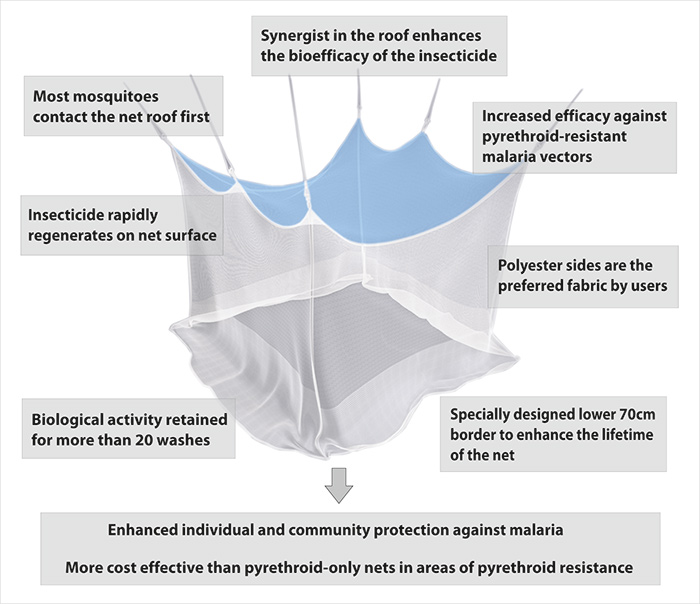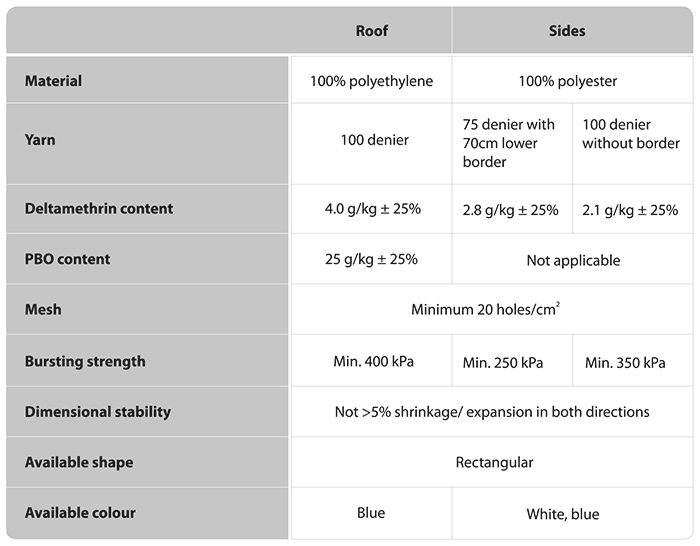Permanet 3.0
PermaNet® 3.0 is the first long-lasting insecticide-synergist combination bed net. It’s the optimal choice for areas where mosquitoes have developed resistance to the insecticides used in standard bed nets.
First Class Vector Control
PermaNet® 3.0 has been developed to address the urgent need for tools with increased efficacy against insecticide resistant malaria vectors. In October 2014, the World Health Organization’s Vector Control Advisory Group published its annual report which included an evaluation of the supporting evidence for Vestegaard’s product claim for PermaNet 3.0. The report noted that PermaNet 3.0 is a “first in class” and stated that “The manufacturers have been very careful to make a relatively modest claim that can be supported by the combined evidence from multiple studies in many areas of pyrethroid resistance.”
- How It Works
- Resistance
- Feature
- Specs
- Claim
- Evidence
- PermaNet® 3.0 is an insecticide-synergist combination net that was designed for use in areas with pyrethroid-resistant malaria vectors.
- The product incorporates the synergist piperonyl butoxide (PBO) with a pyrethroid insecticide (deltamethrin) in the roof section.
- A synergist is a chemical that enhances the effect of the primary insecticide used; it increases the exposure of an insect to the insecticide as though the dose had been increased.
- The main way that PBO enhances the effects of deltamethrin is by inhibiting the metabolic enzyme defense systems within the insect
- Insecticide resistance affects all major malaria vector species and all classes of insecticides.
- Resistance to pyrethroids seems to be the most widespread.
- The two main mechanisms of pyrethroid resistance are metabolic resistance (cytochrome P450s and esterases) and target-site resistance (kdr mutations).
- Metabolic resistance either alone or combined with other mechanisms is more likely than kdr alone to cause control failure.
- Judicious use of insecticides is required to prevent resistance from emerging at new sites and to maintain effectiveness of vector control interventions in the short, medium and long term.
- Preserving and prolonging the susceptibility of malaria vectors to pyrethroids is critical to sustain malaria control.


- PermaNet® 3.0 has been evaluated by the World Health Organization Pesticide Evaluation Scheme and in 2008 received an interim recommendation as a long-lasting insecticidal net.
- The product has a specific claim related to its efficacy with resistant malaria vectors: Relative to pyrethroid-only LLINs, PermaNet® 3.0 has increased efficacy against malaria vectors with cytochrome P450 based metabolic pyrethroid resistance, even if combined with kdr.
PermaNet® 3.0 has been comprehensively assessed in many settings for efficacy against pyrethroid-resistant populations of Anopheles.
- Data from village studies clearly indicate higher bioefficacy of PermaNet® 3.0 than pyrethroid-only long-lasting insecticidal nets (LLINs) against field populations of pyrethroid-resistant Anopheles.
- Data from experimental hut studies in areas with pyrethroid resistant Anopheles demonstrate increased efficacy when compared to pyrethroid-only LLINs.
- Data from lab studies with wild resistant Anopheles demonstrate consistently high efficacy with PermaNet® 3.0 and reduced efficacy with most other pyrethroid-only LLINs.
- Modelling indicates that PermaNet® 3.0 is more cost effective than standard pyrethroid-only LLINs in areas with pyrethroid resistance.
